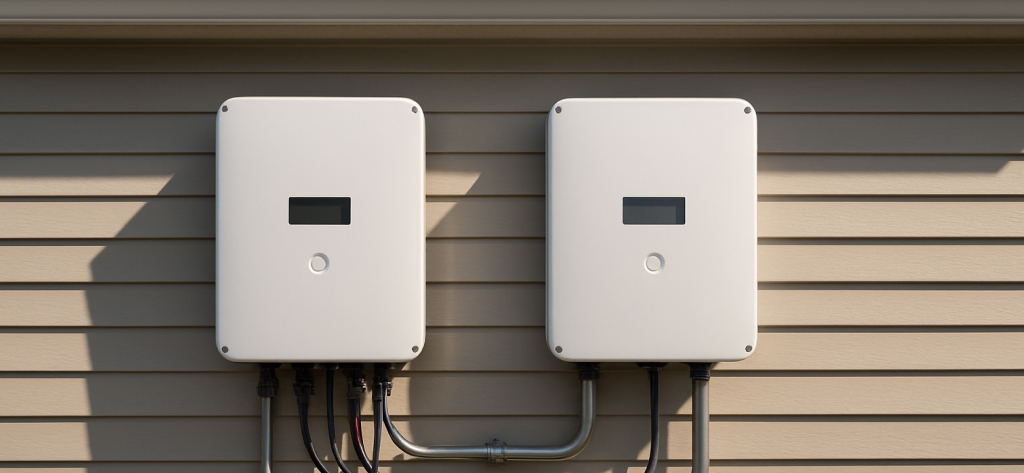Article
Solar Inverters 101

Solar inverters play a key role in solar energy systems by converting direct current (DC) generated by your solar panels into alternating current (AC), the kind of energy that keeps the lights on in your home. As solar energy becomes more popular, understanding the differences between microinverters, string inverters, and power optimizers is crucial for homeowners. This knowledge empowers you to make smart choices that boost your solar system’s efficiency and performance, ultimately getting the most out of your investment.
Thanks to recent advancements in inverter technology, solar systems are more efficient than ever. With so many homeowners considering solar energy, picking the right inverter type is more important now than ever. In this post, we’ll break down each inverter type, look at their pros and cons, and help you figure out which one fits your needs the best.
Microinverters vs. String Inverters vs. Power Optimizers
It’s important to know how each inverter works and how they can impact your energy production.
Microinverters are compact devices mounted directly on each solar panel, allowing each panel to function independently. This design maximizes energy harvest, ensuring each panel can perform at its best—especially when shading or debris gets in the way. For more details on how solar panels handle various situations, check out our article on how solar panels work for your home.
In contrast, string inverters represent a more traditional approach. They connect multiple solar panels in a series, or “string.” While these inverters are generally simpler and more budget-friendly, they come with a significant drawback: the performance of the entire string relies on the weakest panel. If one panel gets shaded or dirty, the entire system can take a hit. String inverters are generally more cost-effective upfront than microinverters, making them a popular choice for many residential installations.
Power optimizers offer a middle ground by combining the best of both microinverters and string inverters. They enhance performance with panel-level optimization while still connecting to a string inverter. This option works well for installations that face variable shading conditions. Learn more about optimizing your energy production with solar battery storage. Power optimizers allow for individual panel monitoring and optimization, making them beneficial in scenarios with shading issues.
Understanding these differences is key to choosing the right inverter for your home. Each option brings unique strengths, so you can find the perfect match for your energy needs and scenario.
The Ups and Downs of Microinverters
Microinverters come with some noteworthy perks, especially if shading is an issue for you. They are designed to maximize energy production, allowing each panel to perform at its full potential. This benefit is especially helpful if your home is surrounded by trees or other obstructions.
Here are some key benefits of microinverters:
- Optimal Performance: With each panel operating independently, you won’t have to worry about lower-performing panels dragging down the overall efficiency.
- Detailed Monitoring: Microinverters let you keep an eye on each panel’s performance, making it easier to spot any issues and address them quickly.
That said, microinverters also have their downsides. The biggest drawback is the higher upfront cost compared to string inverters, which might deter some homeowners, especially those on a budget. However, it’s worth noting that while the initial investment is steeper, the potential for long-term savings through improved performance can more than make up for that.
The Pros and Cons of String Inverters
String inverters can be an attractive option for those looking to save a bit of cash on their solar investment. Here’s what makes them appealing:
- Lower Upfront Costs: Typically, string inverters are less expensive to purchase and install, making them accessible for many homeowners.
- Simpler Installation: The installation process tends to be more straightforward than with microinverters, which can help save on labor costs.
On the flip side, string inverters do face some challenges. Their performance can take a serious hit from shading; if even one panel in the string gets shaded, the whole system suffers. Therefore, if your roof is prone to shading, it’s important to think carefully about whether string inverters are the right choice, as this can lead to missed energy production opportunities.
Knowing When to Choose Power Optimizers
Power optimizers shine in solar setups that deal with uneven shading throughout the day. They take the best parts of both microinverters and string inverters to boost overall energy production while keeping the inverter system simple. Here are some situations where power optimizers excel:
- Variable Shading: If your home has trees or buildings that occasionally cast shadows on your panels, power optimizers will help each panel perform at its peak, no matter the shading.
- Upgrading Existing Systems: You can add power optimizers to your existing solar system without needing a complete overhaul. This makes them a fantastic choice for homeowners who want to improve the efficiency of their current setup.
By opting for power optimizers, you gain more control over your energy production, along with a modern and flexible inverter solution.
Costs and Warranty Insights
When choosing the right inverter for your solar system, cost is a big deal. Installation costs for microinverters usually land between $400 to $2,000 per unit. Even though this might seem high at first, keep in mind that the potential for significant long-term savings through efficiency and durability can make them a smart pick.
String inverters, on the other hand, often boast a lower initial price, making them appealing for first-time solar buyers. But it’s crucial to assess the long-term value, as shading can impact performance and your return on investment.
Warranty length is another key consideration. Most modern solar inverters, whether micro or string, come with warranties ranging from 10 to 25 years. Be sure to scrutinize these warranties, as they can protect your investment against future problems and unexpected expenses.
Shade Performance and Monitoring Insights
How well your solar inverter performs can greatly impact your overall energy generation, especially when the sun isn’t shining brightly. Microinverters do a great job here because they allow each panel to work independently, meaning that shading on one panel won’t hurt the others. This setup helps you get the most out of your energy production, even in tricky conditions.
On the other hand, string inverters can struggle in shaded situations, since their performance hinges on the weakest panel in the string. This reliance can lead to decreased efficiency, making microinverters or power optimizers more appealing choices for homeowners facing varied shading issues.
The monitoring capabilities of microinverters stand out. They provide detailed performance data for each panel, which helps in proactive maintenance and ensures everything runs smoothly over time. This level of insight can lead to quicker troubleshooting and a significant boost in overall efficiency.
Making Your Inverter Choice
Choosing the right solar inverter isn’t just about optimizing your home’s energy production; it’s a key part of making a sound investment. Microinverters, string inverters, and power optimizers each come with their unique features, advantages, and drawbacks. Take the time to weigh factors like shading conditions, budget, and desired monitoring features when selecting your inverter.
Connecting with a solar energy expert can provide tailored guidance and insights, making sure you land on the best choice for your specific needs. Putting in the effort to find the right inverter can lead to improved efficiency, substantial energy savings, and a better return on your investment down the road.
Frequently Asked Questions
What are the main differences between microinverters and string inverters?
Microinverters operate on a panel-by-panel basis, giving them an edge in shaded conditions. On the other hand, string inverters connect multiple panels in a series, offering a cost-effective option upfront, but their performance can drop if one panel is shaded.
How do microinverters perform in shaded conditions compared to string inverters?
Microinverters perform better in shaded scenarios, as they allow each solar panel to generate power independently. This independence prevents performance dips caused by shading on just one panel, ensuring you maximize energy production.
What factors should I consider when choosing an inverter for my solar system?
When selecting an inverter, think about:
- Performance in shaded conditions
- Initial installation costs
- Warranty lengths
- Monitoring capabilities
These aspects will significantly affect both the short-term experience and the long-term value of your solar installation.
Want a Free Solar Estimate?
Fill out the form to get started today.


